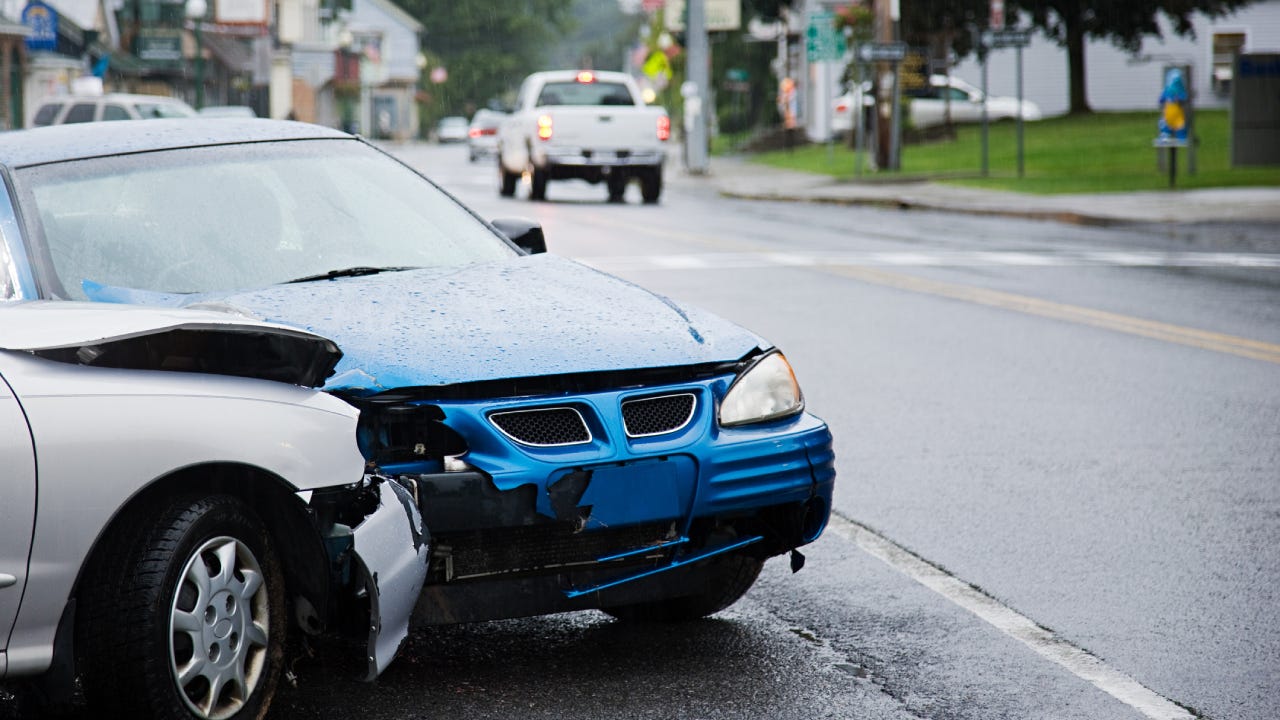PIP insurance in New York

The Bankrate promise
At Bankrate, we strive to help you make smarter financial decisions. To help readers understand how insurance affects their finances, we have licensed insurance professionals on staff who have spent a combined 47 years in the auto, home and life insurance industries. While we adhere to strict , this post may contain references to products from our partners. Here's an explanation of . Our content is backed by Coverage.com, LLC, a licensed entity (NPN: 19966249). For more information, please see our .
Key takeaways
- PIP, or Personal Injury Protection, is a kind of auto insurance that covers your medical expenses and lost income after an accident, no matter who caused it.
- In New York, PIP coverage is mandatory, and it needs to have a minimum coverage of $50,000 for injuries from one accident.
- Along with medical bills and lost earnings, PIP insurance in New York could also cover expenses like household costs.
Many states require drivers to have a minimum level of auto insurance coverage to drive legally. New York is among the states where drivers must also have personal injury protection coverage (PIP). When purchasing car insurance in New York, PIP becomes a mandatory component of your policy. Choosing the appropriate PIP insurance in New York involves understanding which coverage aligns with your requirements and financial situation. Bankrate’s insurance editorial team offers insights into how PIP operates in New York, helping you secure the necessary coverage.
What is PIP insurance?
Personal injury protection, or PIP, is a required coverage in most no-fault states. You may even hear it referred to at times as no-fault insurance. PIP coverage ensures that the cost of medical expenses and lost wages as a result of a car accident are covered, at least in part, for the driver and any passengers in the vehicle, regardless of who was at fault for the accident. While you may wonder if you do need PIP insurance if you have health insurance, it is worth remembering that these types of insurance products provide coverage for different things.
In addition to personal injury protection in New York, drivers are also required under New York car insurance laws to carry at least the minimum levels of several other types of coverage to drive legally. This includes liability coverage, which pays for any damages done to another person (beyond what PIP covers) or property. You will also need to maintain statutory uninsured motorist bodily injury coverage, which helps to cover any injuries sustained in an accident with a person who does not have insurance.
How does New York PIP work?
If you are involved in an accident as a driver in New York, PIP coverage will help to pay your medical expenses and lost wages that are the result of that accident. Coverage is provided up to your policy’s limit. As New York is a no-fault state, PIP coverage kicks in no matter who is at fault for the accident. However, that does not mean that one party is not considered at fault for an accident. While PIP is paid out first, car insurance companies will still determine which driver is considered primarily responsible for the accident and that driver’s liability coverage will pay for any additional medical bills or property damage.
Here is how PIP insurance in New York works:
- It helps pay for medical costs and lost wages incurred in an accident.
- It helps pay for some essential services if you cannot complete household responsibilities due to an injury from an auto accident.
To understand this, here is an example of PIP in action: Let’s say you are driving through an intersection with a green light, and another driver runs a red light and hits the side of your car. You both sustained minor injuries in the accident. Your personal injury protection coverage pays for your medical expenses up to the limit on your policy. The other driver’s PIP covers their own injuries. The insurance companies review the account of the accident from you, the police and the other driver and determine the other driver to be at fault. At that point, their liability coverage would kick in and pay for any of your additional medical expenses not paid by your PIP coverage.
The minimum PIP coverage amount in New York is $50,000. You can always add Additional PIP coverage and Optional Basic Economic Loss (OBEL) coverage to extend your cap for coverage. Additional PIP extends your PIP coverage another $50,000 (for a total of $100,000 in coverage). OBEL offers an additional $25,000 of basic economic loss coverage, which includes payouts for lost wages, rehabilitation after an injury and other forms of economic loss.
There are some situations where you cannot use PIP coverage in New York, including if you are riding in an ATV or are injured while committing a felony. Additionally, if you’re found to have been intoxicated, your PIP coverage may pay for emergency health services, but your insurer has the right to collect that money back from you.
Is PIP required in New York?
PIP insurance in New York is mandatory. You must carry at least $50,000 of PIP coverage as part of your auto insurance policy. Most states in the U.S. maintain some type of minimum car insurance requirement to legally drive in the state. In New York, minimum coverage requirements are:
- $25,000 bodily injury liability per person and $50,000 death per person
- $50,000 bodily injury liability per accident and $100,000 death per accident
- $10,000 property damage liability per accident
- $50,000 personal injury protection (PIP)
- $25,000 statutory uninsured motorist bodily injury per person
- $50,000 statutory uninsured motorist bodily injury per accident
Statutory uninsured motorist statutory coverage only provides coverage if the accident happens within New York. Outside of state lines, your statutory coverage would not apply. You can purchase supplemental uninsured motorist coverage, which offers uninsured and underinsured motorist coverage both inside and outside of the state, but it is not required as part of the minimum coverage for New York.
How much does PIP cost in New York?
The average cost of car insurance in New York is $3,833 per year for full coverage and $1,654 for minimum coverage. Auto insurers in New York cannot sell you less than the minimum amount of coverage required by the state, so the minimum amount of PIP coverage you need will be included in any quotes you receive, regardless of the coverage options you select.
Your actual cost for PIP insurance in New York will vary based on a number of factors, including details about your driving history, age, location and information about your vehicle, such as its age, make and model. When you apply for auto insurance, the insurance provider will give you an insurance quote that provides an estimated premium based on the coverage you select as well as the level of risk it assumes you present based on these and other factors.
Once you have secured coverage, you can see exactly how much you are paying for PIP by looking at your policy’s declarations page, which includes details about your policy.
Key things to note about PIP insurance in New York
PIP is a commonly misunderstood type of car insurance coverage. If you live in New York, keep these key things in mind when it comes to your personal injury protection:
- PIP kicks in regardless of fault after an accident
- It only covers medical costs, lost wages and some other costs incurred as a result of the accident; it does not cover property damage
- Even though PIP kicks in regardless of fault, it does not mean that none of the drivers involved in the accident will be considered at fault
- New York’s minimum car insurance requirements are higher than many states, partly due to PIP coverage, which means the average cost for minimum coverage car insurance in the state is higher than the national average
Frequently asked questions
-
-
You can file a PIP claim up to 30 days after an accident if injuries are involved, according to the New York State Department of Financial Services. This claim can be for injuries you sustained or for injuries sustained by passengers in your vehicle. The claim should be filed no matter who is at fault for the accident since PIP extends coverage regardless of fault.
-
These coverage types are similar in that both can pay for medical costs for you and your passengers regardless of fault, but there are differences. Medical payments coverage only pays for medical costs such as hospital visits, surgery and other qualified medical charges, or funeral expenses. PIP will pay for these same expenses, but also rehabilitation, lost wages if you are out of work due to the accident and household help while you’re recovering from your injuries.
-
Your PIP coverage will only pay up to your policy limit, and the minimum requirement for coverage is $50,000. If you are at fault for an accident, you could be responsible for additional expenses beyond the limit of your coverage unless you have also purchased supplementary medical payments coverage. If you have health insurance, some expenses may be paid by that policy as well. If another party is found to be at fault in the accident, their bodily injury liability coverage could pay for your medical expenses. You may also have the ability to sue for certain costs, although New York only allows drivers to sue after a PIP claim if they meet certain qualifications.
-
Typically, no-fault states prohibit filing claims against another person’s insurance over an accident. However, if the damages that are sustained as a result of the accident exceed the threshold of the serious injury exception, a person may be subject to a suit for additional damages.
-

